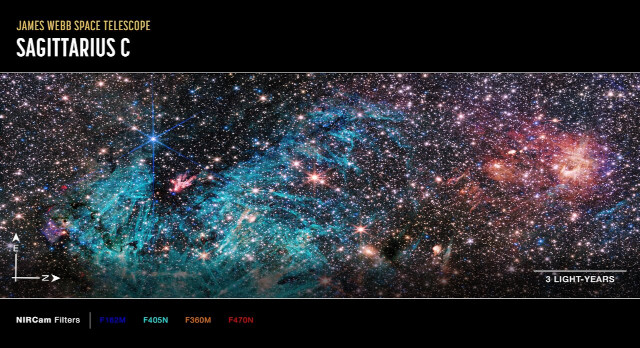
An image captured with the James Webb Space Telescope shows a star-forming area cataloged as Sagittarius C just 300 light-years away from Sagittarius A*, the supermassive black hole at the center of the Milky Way. In the heart of the galaxy, among half a million stars, there’s a cluster of protostars in the middle of a cloud so dense that the stars behind it are obscured even to the most powerful existing telescope. In contrast, protostars are visible to the NIRCam instrument in detail along with cosmic features that were previously unknown and astronomers have yet to identify.
The image (NASA, ESA, CSA, STScI, S. Crowe (UVA)) shows the area cataloged as Sagittarius C as seen by the James Webb Space Telescope’s NIRCam instrument. The protostar cluster appears as a sort of reddish cavity in a cyan-colored area.
The supermassive black hole Sagittarius A*, or simply Sgr A*, at the center of the Milky Way, is an object that was studied repeatedly but there’s an extreme environment around it that contains many other interesting objects, including stars and protostars. There are also large amounts of gas and dust that make observations difficult, a situation in which infrareds are among the few electromagnetic emissions that pass at least partly through the cloud and the cocoons in which protostars are forming. This is one of the reasons that led to the design of telescopes that are increasingly sensitive to infrareds.
The James Webb Space Telescope’s NIRCam (Near-Infrared Camera) instrument is the one used to capture the details of the stars forming in the area that was cataloged as Sagittarius C, or simply Sgr C. In cosmic terms, it’s really close to the supermassive black hole, as it’s about 300 light-years away from it. It’s a chaotic environment and yet even there new stars manage to form. In the heart of Sgr C, there’s a previously known protostar whose mass is over 30 times the Sun’s.
NIRCam also captured large-scale emissions generated by ionized hydrogen around the large cloud’s lower side, visible in cyan in the image. Usually, that’s the result of energetic photons emitted by young massive stars but the region shown by the James Webb Space Telescope is truly vast, a surprise to astronomers. Needle-like structures in the ionized hydrogen appear chaotically oriented in many directions and constitute a further object of investigation.
About 25,000 light-years away from Earth, Sagittarius C offers the possibility of examining star formation processes in an environment full of turbulence. For example, astronomers want to understand whether more massive stars form near the center of the Milky Way than at the edges of the spiral arms.
The James Webb Space Telescope offered an unprecedented view of an area near the center of the Milky Way. Given the presence of emissions and needle-like structures, it’s possible that the researchers who conducted these observations have material for more than one study and for follow-up studies to better understand what’s happening in the heart of the galaxy.

